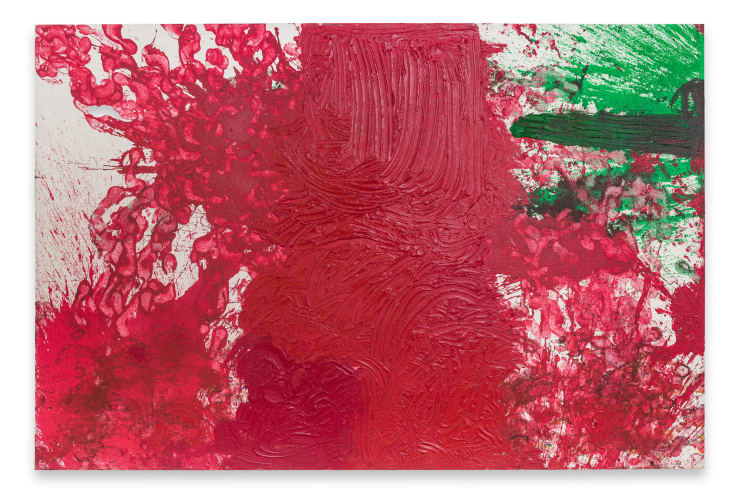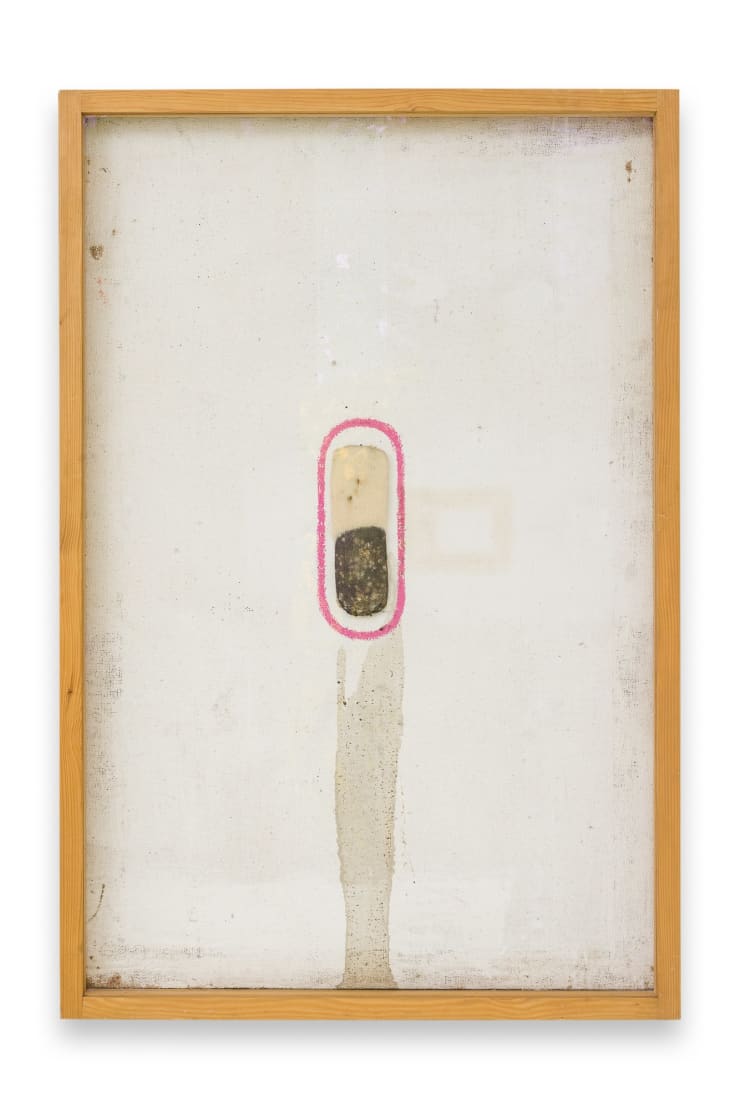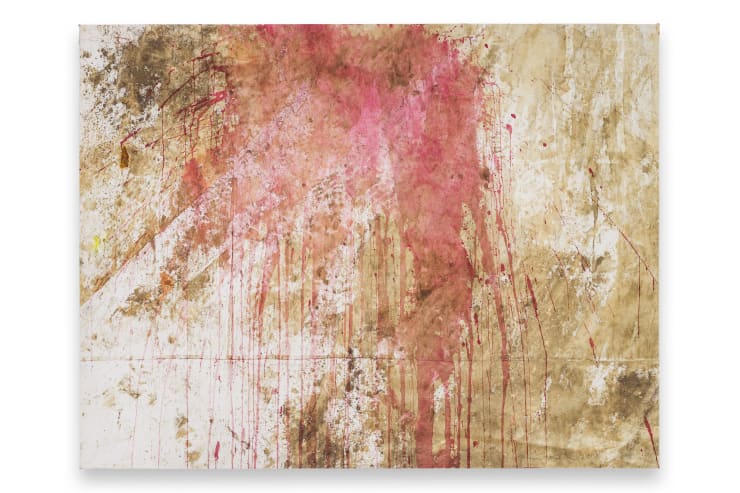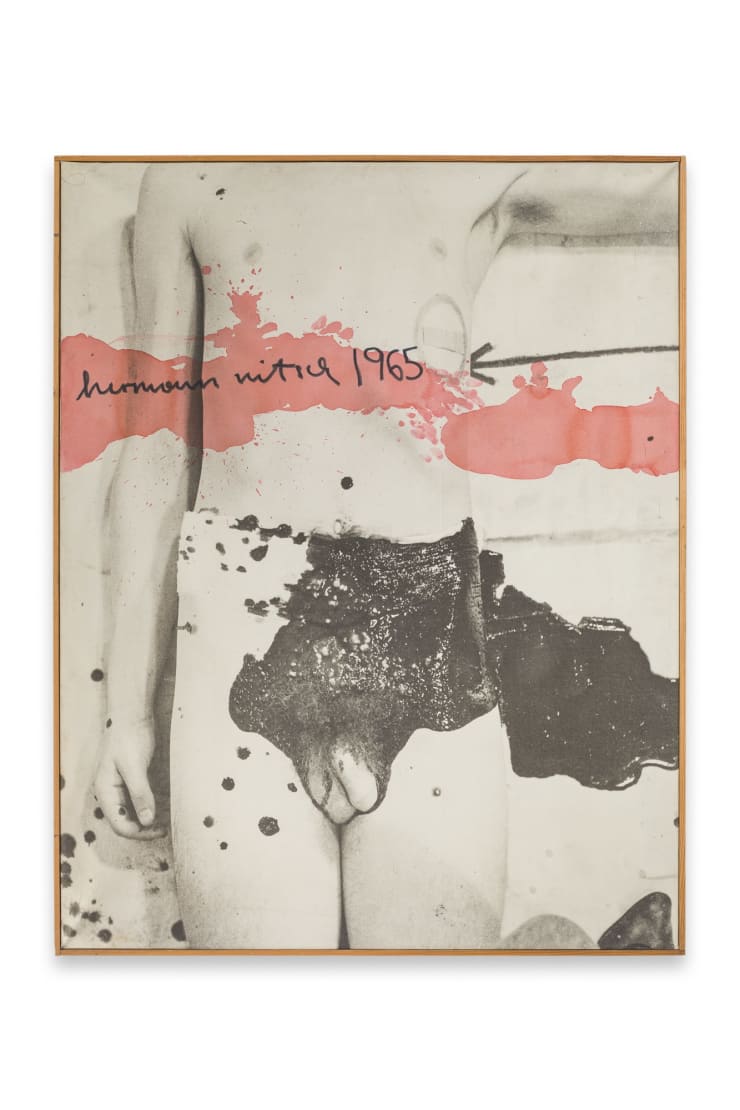Hermann Nitsch
Hermann Nitsch was born on August 29, 1938 in Vienna. He is the crucial founder of Viennese Actionism and is regarded as one of the most versatile contemporary artists: action performer, painter, composer (symphonies, organ concerts), and set designer. His synthesis of the arts, the Theatre of Orgies and Mysteries, encompasses the broad spectrum of his art by calling on all five senses – the tragic leads us to becoming involved with flesh, blood and intestines.
Just before completing his training at the Graphische Lehr- und Versuchsanstalt in Vienna with a diploma (1953-1958), Nitsch takes a position as a commercial artist at the city’s technical museum in 1957. Privately Nitsch focuses his artistic interest initially on Expressionism, which he links to mostly religious figurative scenes. Beginning in 1960, following a period in which Nitsch had turned more towards literature, he returned to painting, creating works in the Arte Informel style. It is in this year that the first painting actions take place, and already they are seeking to realize the idea of the Theatre of Orgies and Mysteries. Revolving around the intensive sensory experience of various substances and fluids, these actions become increasingly provocative in the coming years. Following screaming and noise action performances, conceived as abreaction plays, Nitsch undertakes the dismemberment of lambs, which lead to further actions involving flesh. After the Theatre proves a resounding success in the US and Germany at the end of the 1960s, Nitsch performs numerous actions throughout the 1970s in cities across Europe and North America.
In 1971 Nitsch is able to acquire Prinzendorf Castle in Lower Austria from the Catholic Church, a purchase that allows him to now also realize his musical ideas for his theatre in large-scale action performances. Noise orchestras, scream choirs and electronically amplified instruments all play a part. Nitsch interprets life as passion, the painting process as a condensed form of life and thus as the very incarnation of passion. Through the painter smock he wears while working, subsequently positioned centrally in the painting, the artist remains present and animates the viewer to identify with the painting process and accompany him into the painting.
The highpoints of Hermann Nitsch’s projects are the “three day play” of 1984 in Prinzendorf or the cycle of pour paintings he creates in 1987 at the Vienna Secession. The ideal of the “six day play” is performed in 1998. Since the 1990s Nitsch’s art is increasingly honoured in a series of exhibitions, which are frequently accompanied by performance actions by the artist. In a changed political and social climate, Nitsch can now establish himself as a universally recognized creative artist.
Hermann Nitsch lives and works at Prinzendorf Castle on the Zaya River, Lower Austria, as well as in Asolo, Italy. His works are exhibited in the two Nitsch Museums in Mistelbach and Naples as well as in the Nitsch Foundation in Vienna and in prestigious international museums and galleries.
Hermann Nitsch passed away in peace on April 18, 2022 after a serious illness at the age of 83.
-
 Herman NitschGPBF_3.Akt_middle_A, 2021Acrylic on Canvas500 x 500 cm
Herman NitschGPBF_3.Akt_middle_A, 2021Acrylic on Canvas500 x 500 cm
196 7/8 x 196 7/8 in -
 Hermann NitschSchüttbild , 1990Acryl auf Leinwand100 x 80 cm
Hermann NitschSchüttbild , 1990Acryl auf Leinwand100 x 80 cm
39 3/8 x 31 1/2 in -
 Hermann Nitsch, Schüttbild, 2021
Hermann Nitsch, Schüttbild, 2021 -
 Hermann NitschSchüttbild, 2002Acryl auf Jute200 x 300 cm
Hermann NitschSchüttbild, 2002Acryl auf Jute200 x 300 cm
78 3/4 x 118 1/8 in -
 Hermann NitschSchüttbild, 2000Acryl auf Jute190 x 285 cm
Hermann NitschSchüttbild, 2000Acryl auf Jute190 x 285 cm
74 3/4 x 112 1/4 in -
 Hermann NitschSchüttbild, 2000Acryl auf Jute190 x 290 cm
Hermann NitschSchüttbild, 2000Acryl auf Jute190 x 290 cm
74 3/4 x 114 1/8 in -
 Hermann NitschSchüttbild, 2009Acryl auf Jute200 x 300 cm
Hermann NitschSchüttbild, 2009Acryl auf Jute200 x 300 cm
78 3/4 x 118 1/8 in -
 Hermann NitschRelikt, 1998Blut auf Baumwollstoff144 x 208 cm
Hermann NitschRelikt, 1998Blut auf Baumwollstoff144 x 208 cm
56 3/4 x 81 7/8 in -
 Hermann NitschBindenbild, 1963Mixed Media126 x 84 cm
Hermann NitschBindenbild, 1963Mixed Media126 x 84 cm
49 5/8 x 33 1/8 in -
 Hermann NitschReliktbild, 2007Blut, Farbe, Kelchdeckel, Pflaster,278 x 217 cm
Hermann NitschReliktbild, 2007Blut, Farbe, Kelchdeckel, Pflaster,278 x 217 cm
109 1/2 x 85 3/8 in -
 Hermann NitschReliktbild mit Applikationen, 2001Blut, Pflaster, Kreide auf Baumwollstoff138 x 298 cm
Hermann NitschReliktbild mit Applikationen, 2001Blut, Pflaster, Kreide auf Baumwollstoff138 x 298 cm
54 3/8 x 117 3/8 in -
 Hermann NitschTragbahre, 2018Bahre, Blut, Kelchdeckel, Gaze200 x 50 cm
Hermann NitschTragbahre, 2018Bahre, Blut, Kelchdeckel, Gaze200 x 50 cm
78 3/4 x 19 3/4 in -
 Hermann Nitsch, Faltplan Jahn Mappe I
Hermann Nitsch, Faltplan Jahn Mappe I -
 Hermann NitschSchüttbild, 2019Acrylic on Canvas200 x 200 cm
Hermann NitschSchüttbild, 2019Acrylic on Canvas200 x 200 cm
78 3/4 x 78 3/4 in -
 Hermann NitschRelikt, überschüttet, 2001Blut und Acryl auf Baumwollstoff116 x 153 cm
Hermann NitschRelikt, überschüttet, 2001Blut und Acryl auf Baumwollstoff116 x 153 cm
45 5/8 x 60 1/4 in -
 Hermann NitschSchüttbild, 2016Acryl auf Leinwand100 x 150 cm
Hermann NitschSchüttbild, 2016Acryl auf Leinwand100 x 150 cm
39 3/8 x 59 1/8 in -
 Hermann NitschUntitled, 1965Photography and Oil on Canvas102 x 126 cm
Hermann NitschUntitled, 1965Photography and Oil on Canvas102 x 126 cm
40 1/8 x 49 5/8 in -
 Hermann NitschReliktbild, 2014Blut mit Applikationen auf Baumwollstoff80 x 100 cm
Hermann NitschReliktbild, 2014Blut mit Applikationen auf Baumwollstoff80 x 100 cm
31 1/2 x 39 3/8 in -
 Hermann NitschO.T., 2020Ölkreide auf Papier21 x 29 cm
Hermann NitschO.T., 2020Ölkreide auf Papier21 x 29 cm
8 1/4 x 11 3/8 in -
 Hermann Nitsch, O.T., 2020
Hermann Nitsch, O.T., 2020 -
 Hermann NitschSchüttbild, 2020Acryl auf Jute200 x 150 cm
Hermann NitschSchüttbild, 2020Acryl auf Jute200 x 150 cm
78 3/4 x 59 1/8 in
„paint is poured and splashed onto a surface and then smeared, pulpy color mass is smeared upon the picture. the painting process becomes a real happening. theatre occurs on the perspective plane. I always say that the painting of the O.M. theatre is the visual grammar of my theatre on such a surface. the intrinsic action, the intrinsic action theatre leaves the places of refuge of the painting itself and goes beyond space to total reality.“
- Hermann Nitsch
Hermann Nitsch (* 1938 in Vienna, † 2022) is regarded as the decisive founder of Viennese Actionism. As an action artist, painter, composer and stage designer, he is one of the most versatile contemporary artists. His Gesamtkunstwerk, the Theater of Orgies and Mysteries, encompasses the broad spectrum of his art by appealing to all five senses.
Beginning in 1960, the artist's first painting actions took place, which already sought to realize the idea of a theater of orgies and mysteries. The actions, which revolved around the intense sensory experience of various substances and liquids, became increasingly provocative in the following years. After scream and noise actions conceived as abreaction plays, Nitsch undertook the dismemberment of lambs, which led to further actions involving meat. After the theater was a resounding success in the U.S. and Germany in the late 1960s, Nitsch performed numerous actions in European and North American cities in the 1970s. In 1971, Nitsch was able to purchase Prinzendorf Castle in Lower Austria from the Catholic Church. The purchase, enabled him to now realize his musical ideas for theater in large-scale action performances. Noise orchestras, screaming choirs and electronically amplified instruments played a role.
Highlights of Hermann Nitsch's projects are the three-day theater piece of 1984 in Prinzendorf or the cycle of Schüttbilder created in 1987 in the Vienna Secession. In addition, in 1998 the realization of his Orgies Mystery Theater took place in the form of a 6-day play. 24 years after the original realization, this summer the Gesamtkunstwerk will be performed again as a concentrated version in a performance of the 1st and 2nd day. The performance will take place on July 30 and 31. The setting for the action is the castle complex in Prinzendorf with all its rooms as well as the surrounding landscape of the Lower Austrian Weinviertel.
Since the 1990s, Nitsch's art has been increasingly honored in a series of exhibitions, often accompanied by performative actions by the artist. Of particular importance are the two major retrospectives at the Essl Collection (2003) and the Gropius Bau Berlin (2007), as well as the tribute to Nitsch through an exhibition at the Albertina in Vienna (2019).
Hermann Nitsch lived and worked at Prinzendorf an der Zaya Castle, Lower Austria, and in Asolo, Italy. His works are exhibited in the two Nitsch Museums in Mistelbach and Naples as well as in the Nitsch Foundation in Vienna and in renowned international museums and galleries.
The artist's credo was "my work should be a school of life, perception and sensation and should be experienced with all five senses". In this sense, the exhibition at Galerie Kandlhofer is dedicated to the presentation of diverse works from different creative phases, which invite the viewer to experience his art with all the senses by incorporating interactive methods. The exhibited works include works from the Bayreuth Valkyrie, New and Historical Works (1960 - 2022), Graphic Works, as well as the installation of a synesthesia room that encourages a sensory experience.
Universal artist Hermann Nitsch was invited by the Bayreuth Festival to provide scenic accompaniment for a concert version of Richard Wagner's "Die Walküre" in the summer of 2021. For all three acts, the artist conceived an extensive painting campaign, which was transformed into bright colors scene by scene with the help of ten painting assistants during the score. Over 1000 liters of paint were spilled per performance. The resulting floor and wall paintings are considered the basis for the overall installation. One of the works created in Bayreuth, in impressive dimensions (5x5m), forms the centerpiece of the exhibition at Galerie Kandlhofer. The work is framed by a number of gold-embroidered shirts that transform the painting into an installation. In addition to the large-scale Schüttbild, other works from 2000 - 2020 consist of an extensive color palette of bright tones, with intense clusters and relief-like haptics. Just as Nitsch aspired to a music of the spheres in his music, he clustered the light of colors in his painting.
A special feature of the exhibition is the synesthesia room (audiovisual design: Frank Gassner), which is presented for the first time in a Viennese gallery. The concept of synesthesia has inspired Nitsch again and again. He combined colors and sounds, painting and literature, music and architecture, movement and stillness, which can be experienced in the installation of the synesthesia room at Galerie Kandlhofer. The installation invites you to surrender to the play of colors in the pictures, enveloped by the music. The monotype tonal work on display maintains the visual simultaneity of the four projectors experienced in the video room through their packaging and distills meaning and pictorial references from it once again.
The drawings and prints are also inseparably connected to the work as a whole and are immediate parts of the work. Hermann Nitsch has been working in the field of printmaking since the 1980s and has produced an extensive oeuvre. The basis of the prints is the architectural drawing, it is the starting point and motif for the majority of the edited graphics. Since 1991 Hermann Nitsch worked together with Kurt Zein. This period is characterized by the impressive expansion of printing possibilities, which of course had a serious impact on the results, which were produced in an elaborate process of several editing steps. For example, printing was done on originals, on handmade paper, on sheets that were individually covered with blood or painted in an actionistic way; the colors were changed sheet by sheet in the printing process, always precisely matched, several plates were printed on top of each other in complicated procedures. The most recent monumental work in the field of graphic art is the large-format, Hebrew-German art book LEVITIKUS, which Hermann Nitsch published together with the publisher Har-El in an edition of 16. It refers to the third book of Moses, which reports on the sacrificial rites in the temple of Jerusalem. The work is accompanied by twelve terragraphs, silkscreen prints with sand, whose material surface structure approximates the texture of the pouring pictures.
-
 Hermann NitschInstallation View, VI
Hermann NitschInstallation View, VI -
 Hermann NitschInstallation View I, 2022
Hermann NitschInstallation View I, 2022 -
 Hermann NitschInstallation View III, 2022
Hermann NitschInstallation View III, 2022 -
 Hermann NitschInstallation View V, 2022
Hermann NitschInstallation View V, 2022 -
 Hermann NitschInstallation View II, 2022
Hermann NitschInstallation View II, 2022 -
 Hermann NitschInstallation View XIII, 2022
Hermann NitschInstallation View XIII, 2022 -
 Hermann NitschInstallation View XIX, 2022
Hermann NitschInstallation View XIX, 2022 -
 Hermann NitschInstallation View XX, 2022
Hermann NitschInstallation View XX, 2022 -
 Hermann NitschInstallation View XXI, 2022
Hermann NitschInstallation View XXI, 2022 -
 Hermann NitschInstallation View IX, 2022
Hermann NitschInstallation View IX, 2022 -
 Hermann NitschInstallation View XVIII, 2022
Hermann NitschInstallation View XVIII, 2022 -
 Hermann NitschInstallation View XXIII, 2022
Hermann NitschInstallation View XXIII, 2022


































